Last updated: March 19, 2025
Article
Climate and Water Monitoring at Gila Cliff Dwellings National Monument: Water Year 2022

NPS/E. SCHNAUBELT
Overview
Together, climate and hydrology shape ecosystems and the services they provide, particularly in arid and semi-arid ecosystems. Understanding changes in climate, groundwater, and surface water is key to assessing the condition of park natural resources—and often, cultural resources.
At Gila Cliff Dwellings National Monument (Figure 1), Sonoran Desert Network scientists study how ecosystems may be changing by taking measurements of key resources, or “vital signs,” year after year—much as a doctor keeps track of a patient’s vital signs. This long-term ecological monitoring provides early warning of potential problems, allowing managers to mitigate them before they become worse. At Gila Cliff Dwellings National Monument, we monitor climate and springs, among other vital signs.
Surface-water conditions are closely related to climate conditions. Because they are better understood together, we report on climate in conjunction with water resources. Reporting is by water year (WY), which begins in October of the previous calendar year and goes through September of the water year (e.g., WY2022 runs from October 2021 through September 2022).
This article reports on results of climate and water monitoring done at Gila Cliff Dwellings National Monument in WY2022.
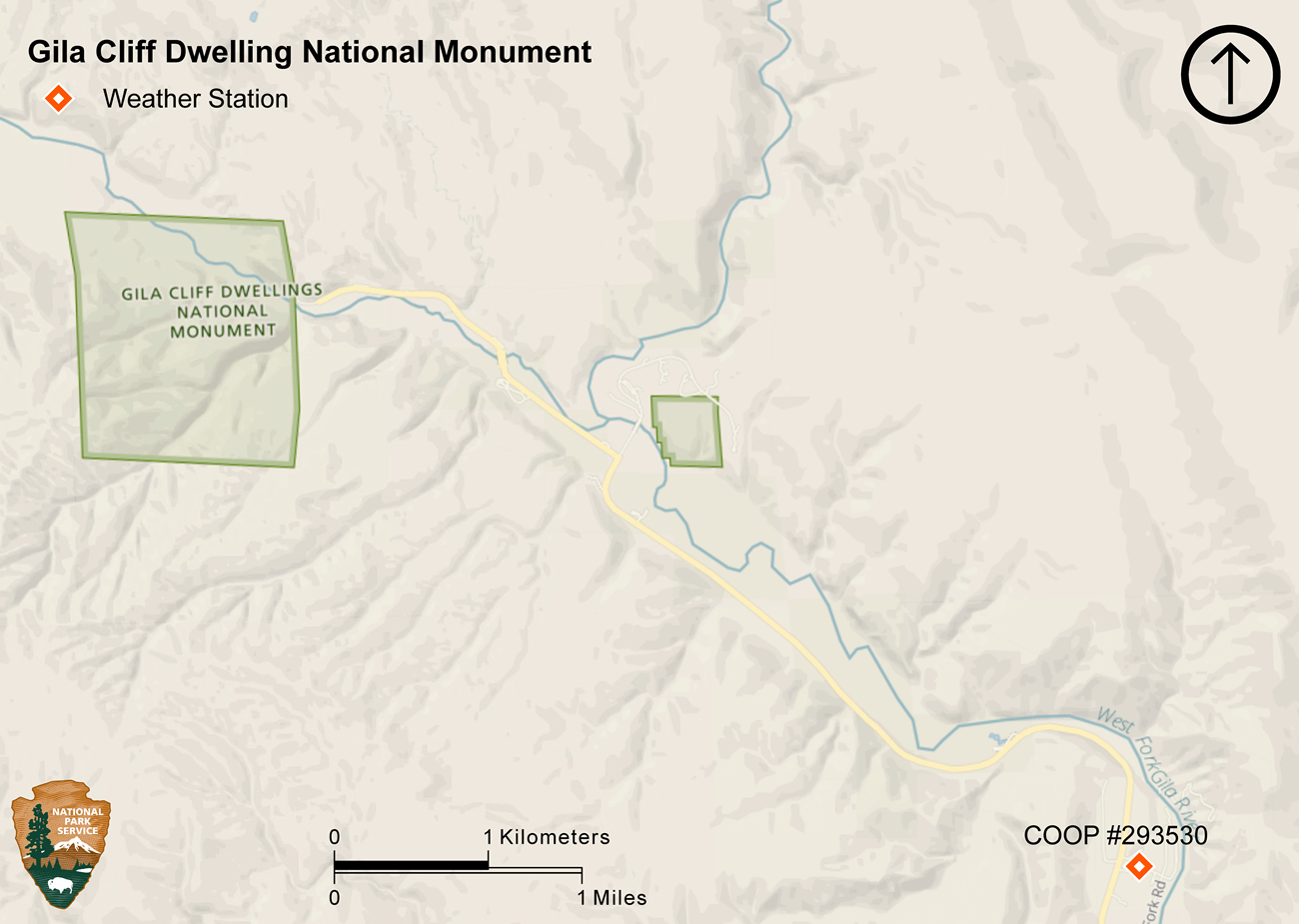
NPS
Climate and Weather
There is often confusion over the terms “weather” and “climate.” In short, weather describes instantaneous meteorological conditions (e.g., it’s currently raining or snowing, it’s a hot or frigid day). Climate reflects patterns of weather at a given place over longer periods of time (seasons to years). Climate is the primary driver of ecological processes on earth. Climate and weather information provide context for understanding the status or condition of other park resources.
Methods
Gila Cliff Dwellings National Monument has had a nearby National Oceanic and Atmospheric Administration (NOAA) Cooperative Observer Program (COOP) weather station since 1957 (Station 293530; see Figure 1). This station provides a reliable, long-term climate dataset used for analyses in this climate and water report. Data from this station are accessible through Climate Analyzer.
Results for Water Year 2022
Precipitation
Annual precipitation at Gila Cliff Dwellings National Monument in WY2022 was 18.35″ (46.6 cm; Figure 2), 3.18″ (8.1 cm) more than the 1991–2020 annual average. Monthly precipitation was below average for the entire year, except during the monsoon season. Early monsoon rains totaled 4.11″ (June), over six times the 1991–2020 June average. July and August received one and a half and twice their average rainfall, respectively. Extreme daily rainfall events (> 1″ or 2.54 cm) occurred on 4 days, twice the average annual frequency of 1.9 days. Extreme rainfall events occurred on 27 June 2022 (1.53″ or 3.8 cm); 10 July 2022 (1.41″ or 3.6 cm); 20 August 2022 (2.05″ or 5.2 cm); and 27 August 2022 (1.05″ or 2.7 cm).
Air Temperature
Mean annual maximum and minimum temperatures in WY2022 were similar to the 1991–2020 annual averages. The mean annual maximum air temperature at Gila Cliff Dwellings National Monument was 74.4°F (23.6°C), 0.9°F (0.5°C) warmer than the 1991–2020 average. The mean annual minimum air temperature in WY2022 was 34.1°F (1.2°C), 0.7°F (0.4°C) warmer than average. Mean monthly maximum and minimum temperatures in WY2022 varied up to 6.0°F (3.3°C) relative to the 1991–2020 monthly average temperatures (Figure 2). On 20 days in WY2022, we recorded extremely hot temperatures (> 93°F, 33.9°C), the same as the 1991–2020 average annual frequency (20.3 days). Extremely cold temperatures (< 12°F, −11.1°C) occurred on 23 days, more than the average annual frequency of 14.7 days.

NPS
Drought
Reconnaissance drought index (Tsakiris and Vangelis 2005) provides a measure of drought severity and extent relative to the long-term climate. It is based on the ratio of average precipitation to average potential evapotranspiration (the amount of water loss that would occur from evaporation and plant transpiration if the water supply was unlimited) over short periods of time (seasons to years). The reconnaissance drought index for Gila Cliff Dwellings National Monument indicates that WY2022 was wetter than the 1991–2022 annual average, from the perspective of both precipitation and potential evapotranspiration (Figure 3).
Reference: Tsakiris G., and H. Vangelis. 2005. Establishing a drought index incorporating evapotranspiration. European Water 9: 3–11.
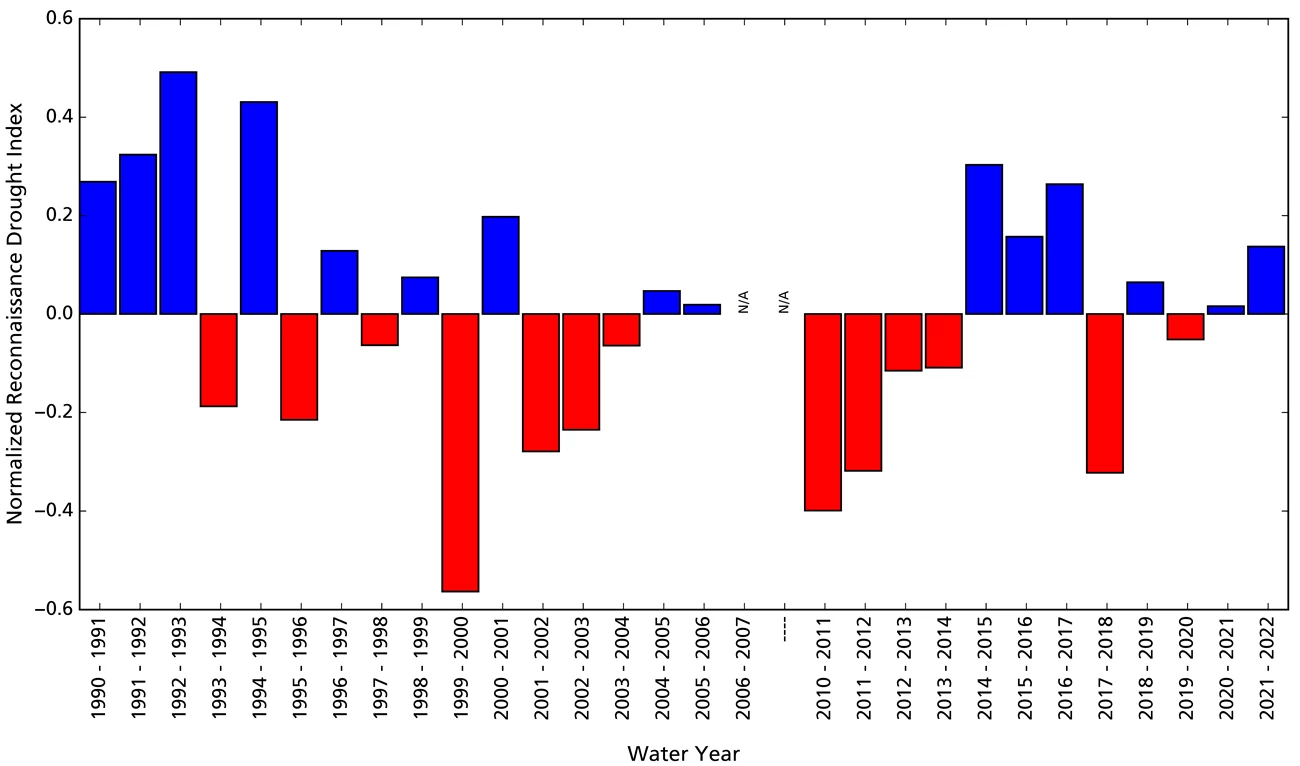
NPS
Springs
Background
Springs, seeps, and tinajas (pools in a rock basin or impoundments in bedrock) are small, relatively rare biodiversity hotspots in arid lands. They are the primary connection between groundwater and surface water and are important water sources for plants and animals. For springs, the most important questions we ask are about persistence (How long was there water in the spring?) and water quantity (How much water was in the spring?).
Methods
Sonoran Desert Network springs monitoring is organized into four modules, described below.
Site Characterization
This module, which includes recording GPS locations and drawing a site diagram, provides context for interpreting change in the other modules. We also describe the spring type (e.g., helocrene, limnocrene, rheocrene, or tinaja) and its associated vegetation. Helocrene springs emerge as low-gradient wetlands. Limnocrene springs emerge as pools, and rheocrene springs emerge as flowing streams. This module is completed once every five years or after significant events.
Site Condition
We estimate natural and anthropogenic disturbances and the level of stress on vegetation and soils on a scale of 1–4, where 1 = undisturbed, 2 = slightly disturbed, 3 = moderately disturbed, and 4 = highly disturbed. Types of natural disturbances can include flooding, drying, fire, wildlife impacts, windthrow of trees and shrubs, beaver activity, and insect infestations. Anthropogenic disturbances can include roads and off-highway vehicle trails, hiking trails, livestock and feral-animal impacts, removal of invasive non-native plants, flow modification, and evidence of human use. We take repeat photographs showing the spring and its landscape context. We note the presence of certain obligate wetland plants (plants that almost always occur only in wetlands), facultative wetland plants (plants that usually occur in wetlands, but also occur in other habitats), and non-native bullfrogs and crayfish, and we record the density of invasive, non-native plants.
Water Quantity
We measure the persistence of surface water, amount of spring discharge, and wetted extent. To estimate persistence, we analyze the variance of temperature measurements taken by logging thermometers placed at or near the orifice (spring opening). Because water mediates variation in diurnal temperatures, data from a submerged sensor will show less daily variation than data from an exposed open-air sensor; this tells us when the spring was wet or dry. Surface discharge is measured with a timed sample of water volume. Wetted extent is a systematic measurement of the physical length (up to 100 m), width, and depth of surface water. It is assessed using a technique for either standing water (e.g., limnocrene and helocrene springs) or flowing water (e.g., rheocrene springs).
Water Quality
We measure core water quality parameters and water chemistry. Core parameters include water temperature, pH, specific conductivity (a measure of dissolved compounds and contaminants), dissolved oxygen (how much oxygen is present in the water), and total dissolved solids (an indicator of potentially undesirable compounds). Discrete samples of these parameters are collected with a multiparameter meter. If the meter failed calibration check(s), we do not present data. Water chemistry is assessed by collecting surface water sample(s) and estimating the concentration of major ions with a photometer in the field. These parameters are collected at one or more sampling locations within a spring. Data are presented only for the primary sampling location. Each perennial spring is somewhat unique, and there are not water quality standards specific to most perennial springs in New Mexico. Where conditions exceed water quality standards for other surface waters (rivers, streams, lakes, and reservoirs), we note it, but the reader is advised that these standards were not developed for perennial springs. Our ongoing data collection at each spring will improve our understanding of the natural range in water quality and water chemistry parameters for a given site.
eDNA
An inventory of rare and invasive species and pathogens in perennial springs was implemented in WY2022 using environmental DNA (eDNA) techniques. Samples were filtered and preserved in ethanol in the field prior to DNA extraction and analysis by the Goldberg Lab at Washington State University.
Target organisms for our eDNA project:
- The non-native invasive American bullfrog (Rana catesbeianus), which is known to occur in large numbers in the West and Middle forks of the Gila River within the Monument (Powell et al. 2006).
- The pathogen chytrid fungus (Batrachochytrium dendrobatidis), a major threat to amphibians globally which is currently expanding in the American Southwest but has not yet been detected at Gila Cliff Dwellings National Monument.
- Ranaviruses, pathogens that can infect amphibians and produce 90–100% mortality in tadpoles and adults and can persist in affected wetlands. Ranaviruses have not been previously detected at the park.
- The native amphibian Chiricahua leopard frog (Rana chiricahuensis), a federally designated threatened species whose historic range included the monument, and which was observed commonly in the area in the 1980s (Powell et al. 2006). Designated critical habitat includes the West Fork of the Gila River within the park.
- The native amphibian lowland leopard frog (Rana yavapaiensis), a species of conservation concern that occurs in the region but has not been observed within the park (Powell et al. 2006).
- The native aquatic snake northern Mexican garter snake (Thamnophis eques megalops), a federally designated threatened species which has not been previously observed within the park (Powell et al. 2006). Designated critical habitat is found near the park at the confluence of the three forks of the Gila River.
- The native mammal jaguar (Panthera onca), a federally designated endangered species, which was historically found within Gila Cliff Dwellings National Monument. The park lies east of the designated critical habitat for jaguar recovery.
Reference: Powell BF and Others. 2006. Vascular plant and vertebrate inventory of Gila Cliff Dwellings National Monument. U.S. Geological Survey (USGS) Open-File Report. USGS Open-File Report 2005-1187. USGS, Southwest Biological Science Center, Sonoran Desert Research Station, University of Arizona. Tucson, AZ.
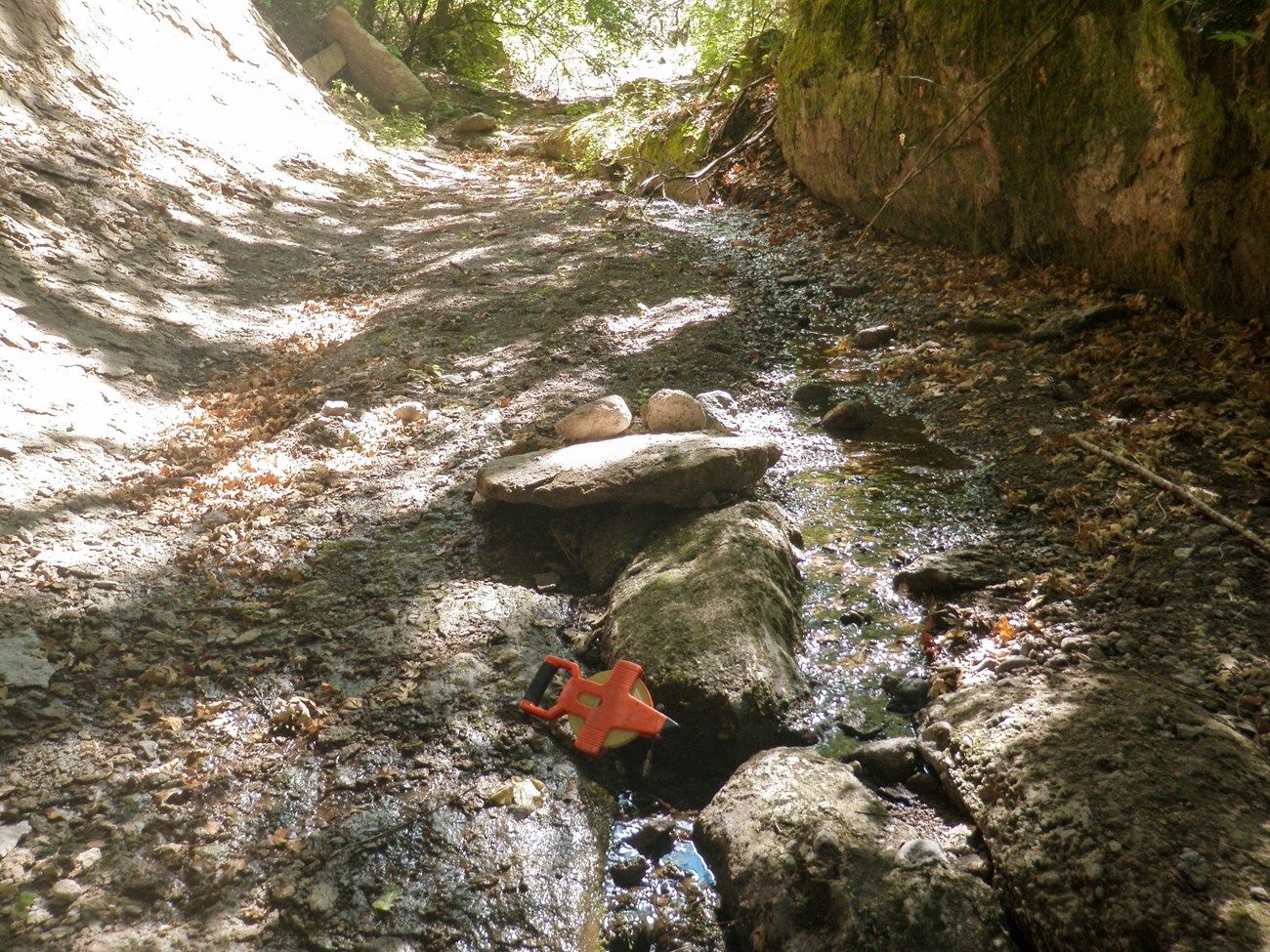
NPS
Recent Findings at Cliff Dweller Canyon Spring
Cliff Dweller Canyon Spring is a rheochrene spring (emerges as a flowing stream) emanating from the base of a large overhanging cliff (Figure 4). When characterized on 22 June 2022, the spring was comprised of a series of small (15–30 cm diameter) pools in the streambed with cold, clear water supporting abundant aquatic insects. Lower Cliff Dweller Canyon Spring (a spring that is not monitored regularly but also emerges from the rhyolite cliff-face) also contained water. It supported a springbrook of more than 0.5 km, though the springbrook did not extend to the Gila River (West Fork) during that dry season. We suspect that Cliff Dweller Canyon and Lower Cliff Dweller Canyon springs are linked into one spring complex, although, unlike Cliff Dweller Spring, Lower Cliff Dweller Spring is often seasonally dry (per observations by monument staff and volunteers).
Site Condition
As in past years, we did not observe disturbance from natural or anthropogenic sources at Cliff Dweller Canyon Spring. We also did not detect crayfish or bullfrogs (non-native, invasive aquatic animals), nor did we observe any non-native plants. The obligate wetland forb monkeyflower (Mimulus sp.) was first observed at Cliff Dweller Spring in 2022, growing in dense linear patches along the springbrook.
Four water samples were collected and filtered (0.45 µm mesh) from the springbrook and pools at Cliff Dweller Canyon Spring on 22 June 2022 to analyze eDNA. None of our target organisms were detected. Data collection for this eDNA inventory continues at this site, and additional information will be provided in a future, more detailed report.
Water Quantity
The WY2022 visit occurred on 22 June 2022, and the spring contained water. Temperature sensors indicated that Cliff Dweller Canyon Spring was ‘wetted’ for all 265 days (100% of days) measured up to the WY2022 visit (Figure 5). In prior water years, the spring was wetted 100% of the days measured.
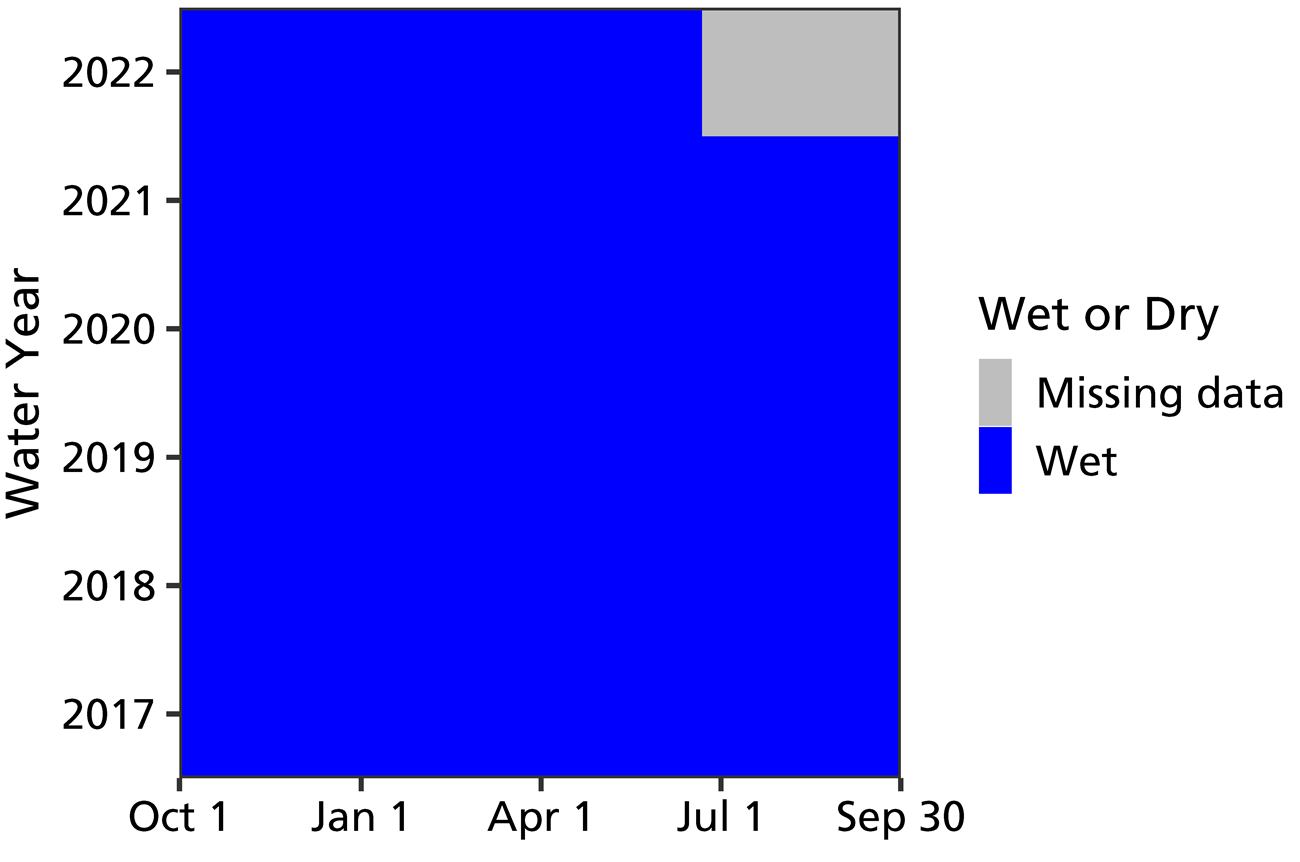
NPS
Discharge was estimated at 7.6 (± 0.3) L/min (2 ± 0.1 gal/min) in WY2022. This was on the lower end of the range of previous discharge measurements at Cliff Dweller Canyon Spring (Table 1).
Wetted extent was evaluated using a method for flowing water. The total brook length was 200–500 m (656–1,640 ft). Width and depth averaged 55.1 cm (21.7 in), and 2.5 cm (1 in), respectively, within the first 100 m—on the lower end of the range observed in past years (Table 2).
Water Quality
Core water quality (Table 3) and water chemistry (Table 4) data were collected at the primary sampling location. The values were generally within the range recorded in prior years, with a few notable exceptions: (1) chloride was almost triple the amount previously observed (Table 4), although still relatively low as compared to many other springs in the region (e.g., Dripping Springs at Organ Pipe Cactus National Monument), and (2) water temperature was about 1.5°C warmer than previously observed (Table 3). Both increased water temperature and chloride may be due to evaporation and reduced water quantity as compared with previous years.
Cliff Dweller Canyon Spring Data Tables
Sampling Location |
WY2022 Value (range of prior values) |
Prior Years Measured (# of measurements) |
|---|---|---|
| 002 | 7.6 ± 0.3 (5.0–31.3) |
2017–2020 (4) |
| Measurement | WY2022 Value (range of prior values) |
Prior Years Measured (# of measurements) |
|---|---|---|
| Width (cm) | 55.1 ± 31.4 (52.6–71.7) |
2017–2020 (4) |
| Depth (cm) | 2.5 ± 0.8 (1.6–2.5) |
2017–2020 (4) |
| Length (m) | 100 (100) |
2017–2020 (4) |
| Sampling Location | Measurement Location (width, depth) |
Parameter | WY2022 Value (range of prior values) |
Prior Years Measured (# of measurements) |
|---|---|---|---|---|
| 003 | Center | Dissolved oxygen (mg/L) | 7.30 (5.27–7.41) |
2017–2021 (4) |
| 003 | Center | pH | 7.54 (7.00–7.52) |
2017–2021 (4) |
| 003 | Center | Specific conductivity (µS/cm) | 218.1 (207.0–276.6) |
2017–2021 (4) |
| 003 | Center | Temperature (°C) | 14.1 (11.2–12.5) |
2017–2021 (5) |
| 003 | Center | Total dissolved solids (mg/L) | 142.0 (134.6–180.1) |
2017–2021 (4) |
| Sampling Location | Measurement Location (width, depth) |
Parameter | WY2022 Value (range of prior values) |
Prior Years Measured (# of measurements) |
|---|---|---|---|---|
| 003 | Center | Alkalinity (CaCO3) |
120 (85–125) |
2017–2020 (4) |
| 003 | Center | Calcium (Ca) |
22 (26–32) |
2017–2020 (4) |
| 003 | Center | Chloride (Cl) |
45 (0–13) |
2017–2020 (4) |
| 003 | Center | Magnesium (Mg) |
2 (6–9) |
2017–2020 (4) |
| 003 | Center | Potassium (K) |
1.8 (b.d.l.–1.9) |
2017–2020 (4) |
| 003 | Center | Sulphate (SO4) |
5 (b.d.l.–4) |
2017–2020 (4) |
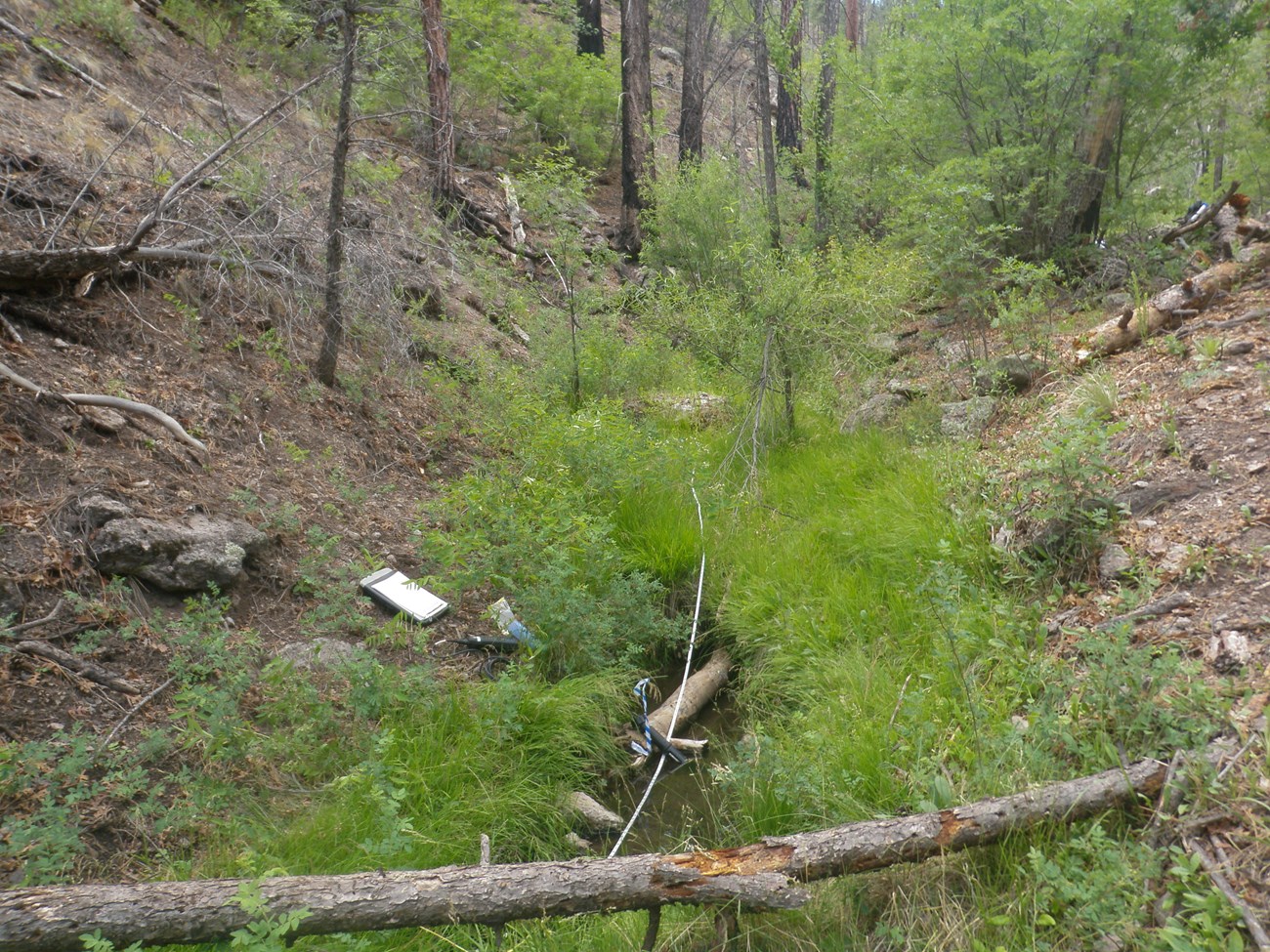
NPS
Recent Findings at Hubbard's Bog
Hubbard’s Bog is a rheochrene spring (emerges as a flowing stream) located in a narrow, north-facing canyon on the south side of the Gila River (West Fork). When characterized during the 23 June 2022 visit, the orifice occurred as a seep at the base of a bedrock outcrop, supporting small willow trees and other riparian plants (Figure 6). About 14 m downstream of the orifice, the first of four open pools emerged, with shallow mucky surface water and thick sedges connecting the pools. The top two pools were shallow and mucky, and contained dense grasses, sedges, and small willow and locust trees. The bottom two pools were bathtub sized, with lots of open water encircled by riparian plants. Aquatic insects were abundant throughout the site. As with Cliff Dweller Canyon Spring, a series of seeps and orifices lower in the canyon suggest a complex of springs, though the lower section appears to be seasonally dry. Descriptions and other characteristics of springs are updated every five years.
Site Condition
Consistent with past years (2017–2021), we rated Hubbard’s Bog as “slightly disturbed” in WY2022 due to the continuing impacts of the 2011 Miller Fire on adjacent tree canopies. Also as in the past, the site was rated “undisturbed” for other natural and human-caused disturbances. We did not observe crayfish or bullfrogs (non-native, invasive aquatic animals), nor did we detect any non-native plants at Hubbard’s Bog in WY2022.
We observed several obligate wetland plant genera that have been present in past years: rushes (Juncaceae sp.), spikerush (Eleocharis sp.), monkeyflower (Mimulus sp.), and willow trees (Salix sp.).
Four water samples were collected and filtered (0.45 µm mesh) from the springbrook and pools at Hubbard’s Bog Spring on 23 June 2022 for eDNA analysis. None of our target organisms were detected. Data collection for this eDNA inventory continues at this site, and additional information will be provided in a future, more detailed report.
Water Quantity
Temperature sensors indicated that Hubbard’s Bog was "wetted" (contained water) for 266 of 266 days (100% of days) measured up to the WY2022 visit (Figure 7). In prior water years, the spring was also wetted 100% of the days measured.
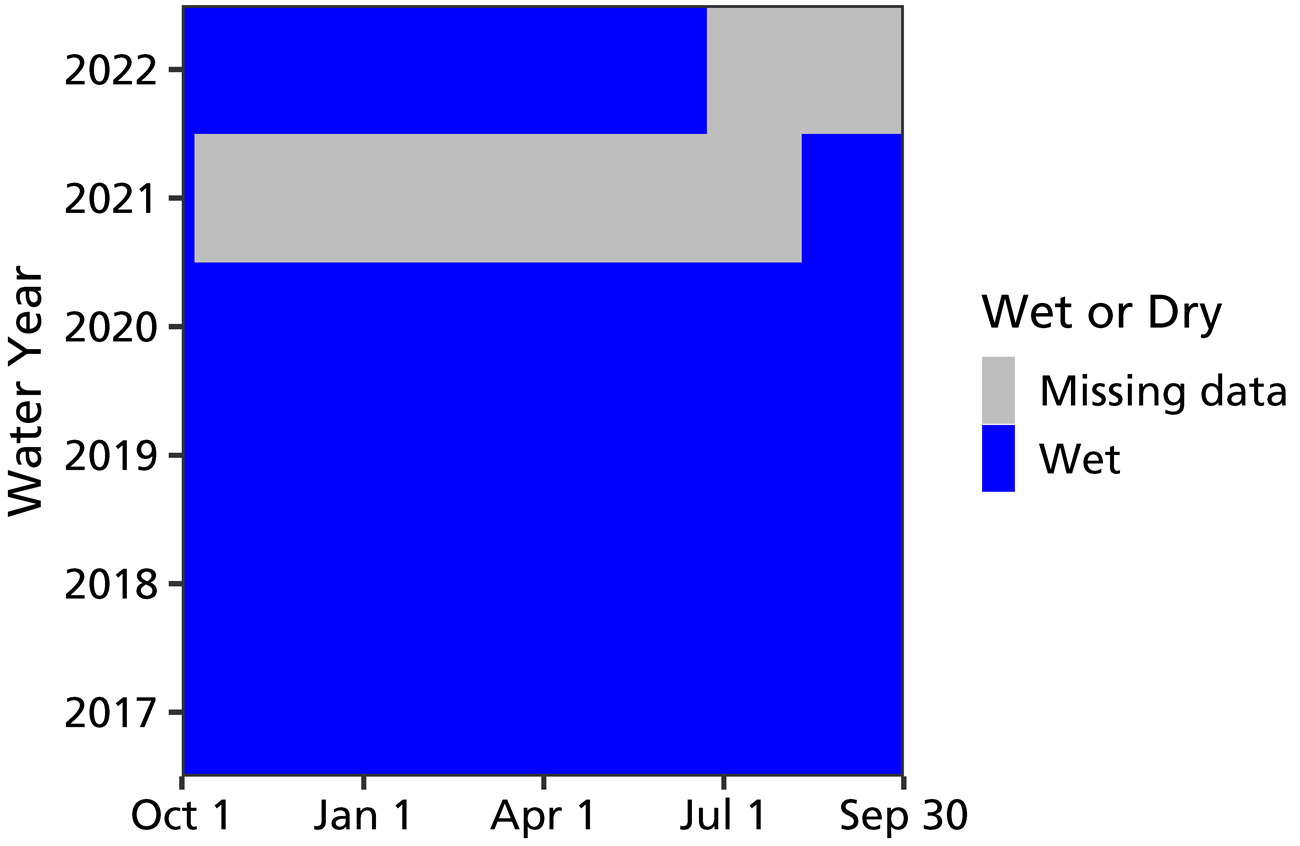
NPS
As in past years, discharge could not be measured in WY2022 as there was no discernable surface flow. Wetted extent was evaluated using a method for flowing water at Hubbard’s Bog in WY2022. The total brook length was 44 m (144 ft). Width and depth averaged 34.9 cm (13.7 in), and 5.6 cm (2.2 in), respectively, within the first 100 m—comparable with measures in past years (2017–2020; Table 5).
Water Quality
Core water quality and water chemistry data were collected at the primary sampling location, although the latter had to be collected with a syringe due to the shallow nature of the pool, which may have influenced those results. We will likely move the primary sampling location to one of the larger pools in future years to avoid this issue. Water-quality values were comparable with past years (Table 6), although specific conductivity and total dissolved solids were lower than previously observed (2017–2021). Perhaps due to collecting water chemistry samples with the syringe, the water chemistry values of Hubbard’s Bog were considerably different than in prior years, with alkalinity and calcium substantially lower and potassium and sulfate substantially higher than observed in past years (Table 7). As in the past, chloride and magnesium remained below the detection level of the instrument.
Hubbard's Bog Data Tables
| Measurement | WY2022 Value (range of prior values) |
Prior Years Measured (# of measurements) |
|---|---|---|
| Width (cm) | 34.9 ± 39.4 (41.4–57.3) |
2017–2020 (4) |
| Depth (cm) | 5.6 ± 6.8 (1.1–4.6) |
2017–2020 (4) |
| Length (m) | 44.0 (33.0–72.4) |
2017–2020 (4) |
| Sampling Location | Measurement Location (width, depth) |
Parameter | WY2022 Value (range of prior values) |
Prior Years Measured (# of measurements) |
|---|---|---|---|---|
| 003 | Center | Dissolved oxygen (mg/L) | 2.95 (0.72–2.96) |
2019–2020 (2) |
| 003 | Center | pH | 7.19 (6.91–7.07) |
2019–2020 (2) |
| 003 | Center | Specific conductivity (µS/cm) | 219.5 (266.1–291.9) |
2019–2020 (2) |
| 003 | Center | Temperature (°C) | 13.8 (12.3–13.8) |
2019–2020 (2) |
| 003 | Center | Total dissolved solids (mg/L) | 143.0 (173.0–189.8) |
2019–2020 (2) |
| Sampling Location | Measurement Location (width, depth) |
Parameter | WY2022 Value (range of prior values) |
Prior Years Measured (# of measurements) |
|---|---|---|---|---|
| 003 | Center | Alkalinity (CaCO3) |
105 (120–140) |
2019–2020 (2) |
| 003 | Center | Calcium (Ca) |
6 (34–40) |
2019–2020 (2) |
| 003 | Center | Chloride (Cl) |
b.d.l. (b.d.l.–0) |
2019–2020 (2) |
| 003 | Center | Magnesium (Mg) |
b.d.l. "(b.d.l.–12) | 2019–2020 (2) |
| 003 | Center | Potassium (K) |
3.6 (0.1–0.5) |
2019–2020 (2) |
| 003 | Center | Sulphate (SO4) |
40 (0–2) |
2019–2020 (2) |
Report Citation
Authors: Kara Raymond, Andy Hubbard, Cheryl McIntyre
Raymond, K., A. Hubbard, and C. McIntyre. 2024. Climate and Water Monitoring at Gila Cliff Dwellings National Monument: Water Year 2022. Sonoran Desert Network, National Park Service, Tucson, Arizona.
